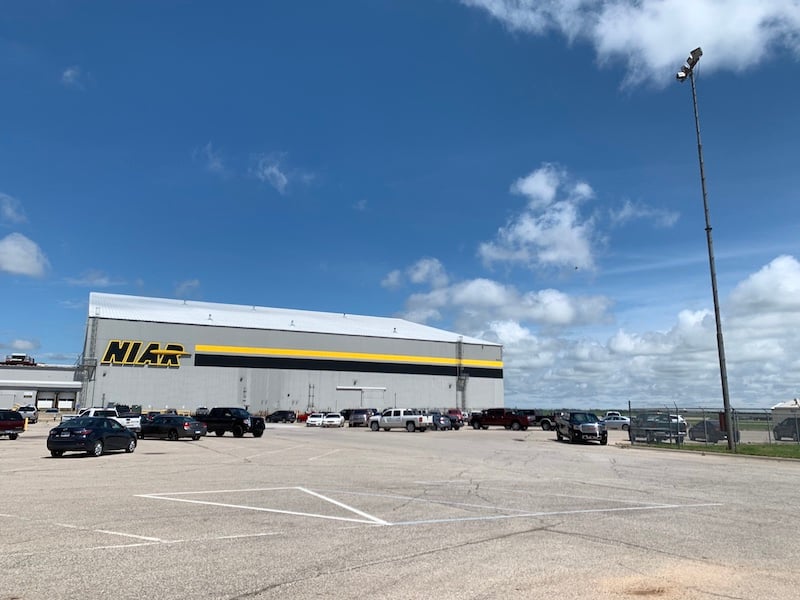Click Here to View This Page on Production Frontend
Click Here to Export Node Content
Click Here to View Printer-Friendly Version (Raw Backend)
Note: front-end display has links to styled print versions.
Content Node ID: 404553
Something big is happening in a cluster of buildings and hangars in Wichita, Kansas, that once served as a modification center for Boeing Co. The National Institute for Aviation Research (NIAR) at Wichita State University (WSU) created an organization two and a half years ago, called NIAR Werx, to provide a host of services to OEMs, suppliers, business, and military aviation companies—especially startups—seeking to do projects as small as one-off parts manufacturing all the way up to retrofitting commercial airliners for special missions and other purposes.
At the same time, it provides real-world learning and experience for WSU engineering students and students enrolled in the airframe and powerplant and avionics programs offered by the university’s technical college, WSU Tech.
David Jones, NIAR Werx director, emphasized that the nonprofit organization doesn’t intend to compete with aviation companies but rather assist them with the manpower and expertise to develop and certify STCs and new products and aircraft to market. “We’re small, nimble, and low-cost,” Jones told AIN. “We’re here to augment them.” And for smaller aviation startups, NIAR Werx offers resources that they don’t have or can’t yet afford to have. “It’s almost like an incubator for new companies, a maker space for aviation,” Jones added.
Originally launched with a cadre of 55 engineers—some of whom were previously employed at the Bombardier Flight Test Center in Wichita—under the designation of NIAR Engineering Design and Modification Team, NIAR Werx now boasts a workforce of 200 engineers, 100 mechanics and technicians, and 45 students working from a handful of buildings that include hangars measuring 111,000 and 47,500 sq ft—with the former one once serving as the hangar where Boeing modified the VC-25s currently being used as Air Force One. A third, 80,000-sq-ft hangar is expected to be added this summer.
NIAR Werx provides a menu of engineering and environmental and electromagnetic test services. Test services such as lightning, burn, ballistics, and high-intensity radiated fields are conducted in a 35,000-sq-ft building.
In June, the organization was awarded an FAA Part 145 certificate for limited airframe and engine work for its MRO services, which will primarily focus on aircraft modifications, Jones noted.
In December, it plans to launch a center for flight-test and certification services from its main facilities in Wichita, which have access to McConnell Air Force Base’s 12,000-foot runway and runs parallel to the former Boeing Wichita property now known as Air Capital Flight Line. Flight testing will also be conducted offsite at Salina Regional Airport—about 90 miles north of Wichita—which has a 12,300-foot runway. Mission control and telemetry can be provided on site in Wichita, as well as through a mobile telemetry trailer that was donated to NIAR Werx by Gulfstream Aerospace.
A partnership with Dynamic NC in nearby Rose Hill, Kansas, allows Werx to offer parts manufacturing including Parts Manufacturer Approval for services such as one-off parts. Dynamic NC’s capabilities also include working with hard metals and large assemblies.

In March, NIAR Werx received the first two of three Boeing 737s for a special-mission modification in partnership with Dynamic Aviation of Bridgewater, Virginia. The unspecified modification involves a team of up to 90 staff and students who will design, modify, test, and obtain STCs for the program. That work is currently being performed in its 111,000-sq-ft hangar.
Another modification project planned for that same hangar is a Boeing 777 passenger-to-freighter program to be carried out in partnership with Sequoia Aircraft Conversions and Kansas Modification Center. The first 777 for conversion is expected within six months, Jones said.
Jones has high hopes for the continued growth of the organization not only in commercial and business aircraft but also in military aircraft, space vehicles, and eVTOLs. Over the next five years, Jones said he envisions the addition of aircraft modification lines in Salina through a collaboration with local MRO 1 Vision and in Topeka.
“This vision maintains the [rationale for] NIAR Werx,” he said, which is to grow the aviation community with applied learning for WSU students and produce experienced A&P and engineering graduates. At the same time, the organization will continue to create value for customers and lower the costs of new development programs for them, Jones added.